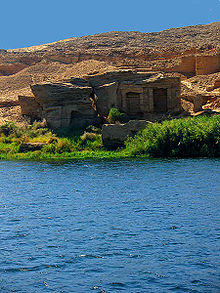
Back المحاجر في مصر القديمة Arabic Pedreres a l'antic Egipte Catalan Canteras en el Antiguo Egipto Spanish Carrières de pierres dans l'Égypte antique French Pedreiras do Antigo Egito Portuguese Kamenolomi drevnog Egipta Serbo-Croatian
This article needs additional citations for verification. (March 2011) |

The stone quarries of ancient Egypt once produced quality stone for the building of tombs and temples and for decorative monuments such as sarcophagi, stelae, and statues.[1] These quarries are now recognised archaeological sites. Ancient quarry sites in the Nile valley accounted for much of the limestone and sandstone used as building stone for temples, monuments, and pyramids.[1] Eighty percent of the ancient sites are located in the Nile valley; some of them have disappeared under the waters of Lake Nasser and some others were lost due to modern mining activity.[1]
Some of the sites are well identified and the chemical composition of their stones is also well known, allowing the geographical origin of most of the monuments to be traced using petrographic techniques, including neutron activation analysis.
In June 2006, the Supreme Council of Antiquities (SCA) of Egypt established a new department for conservation of ancient quarries and mines in Egypt. The new department was designed to work in close cooperation with the regional SCA offices, and special training programmes for Inspectors of Antiquities will be carried out to enable the regional authorities to tackle inventory, documentation, risk assessment and management of the ancient quarries and mines.
This article details some of the most important ancient quarry sites in Egypt, listing material type and known monuments using sourced material when known. Quarry sites are listed by location from North to South.
- ^ a b c Abu-Jaber, Nizar, ed. (2009). QuarryScapes: ancient stone quarry landscapes in the Eastern Mediterranean. Geological survey of Norway special publication. Trondheim: Norges Geologiske Undersøkelse. ISBN 978-82-7385-138-3.